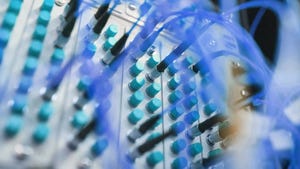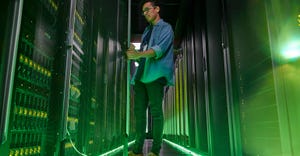HPE Boss Targets AI Inference Sales After $14B Juniper Deal
HPE CEO Antonio Neri says AI deployed at the edge of the network will be 'massive' for his company after its Juniper takeover goes through.

This article originally appeared in Light Reading.
Mega mergers between network equipment vendors don't have a great track record. The various companies bolted together to form today's Nokia have at times this century looked like a Frankenstein's monster of parts lurching from one mishap to another. So, when HPE, with its $29 billion in annual sales this year, revealed plans to acquire the $5.6 billion-a-year Juniper Networks, many long-in-the-tooth industry observers may have questioned the wisdom of the $14 billion move.
Some are concerned telecom will become less of a priority after Juniper, with its biggish service provider business, is subsumed into the much larger HPE, which caters mainly to enterprise customers. For others, the integration of HPE's Aruba networking business with Mist, an overlapping unit at Juniper, is where the deal could turn nasty. Pitching the why and how of all this to customers, investors, and partners looks challenging, to say the least.
Yet numerous analysts have made broadly positive remarks about the acquisition. And one senior telco executive, speaking on condition of anonymity, also believes there is a strong rationale for a merger of the IT and networking players. To overcome the doubts and promote what HPE and Juniper could do in tandem, HPE boss Antonio Neri made a high-profile appearance last week in Barcelona at Mobile World Congress. Dedicated to networking and related matters, the trade show this year attracted more than 100,000 visitors, according to the GSM Association (GSMA), its organizer.
In an environment that backed up his claims, Neri was quick to dismiss any suggestion that an HPE-and-Juniper combo may have a diminished interest in telecom. Even before the Juniper takeover, he told Light Reading, telecom is one of HPE's two largest verticals, the other being financial services. HPE's compute systems are already embedded in the equipment sold by the likes of Ericsson and Nokia, he said, while some 40 operators worldwide have involved HPE in their virtualization efforts. "The Juniper acquisition makes us even more relevant in the telco space."
A 'Strong Alternative' to Cisco
But the broader deal logic is about creating a much stronger, AI-fit rival to Cisco, the big competitor to Juniper in the market for Internet routers and switches. "We will clearly be the strong alternative," said Neri. He said he is confident that pooling the technologies of HPE and Juniper will produce capabilities "Cisco does not have." And he reckons the biggest long-term opportunity lies in what the industry refers to as "AI inferencing."
Until now, most of the AI action has taken place inside hyperscalers' data centers, where clusters of Nvidia's expensive graphical processing units (GPUs) have been set to work on training large language models (LLMs) for generative AI (GenAI). At the inference stage, when live data is exposed to fully trained models, AI applications could feasibly have less need for compute power, allowing companies to host them in smaller "edge" facilities much closer to end users. "I think this vision of edge computing becoming AI inferencing at the end of the network is massive for us," said Neri.
One goal, then, is to "reverse integrate" some of HPE's AI and software assets into the portfolio of products that Juniper sells for metro area networks. Where GPUs are deployed, HPE and Juniper will be able to position Ethernet, a technology well known to the telco sector, as an option for connecting chip clusters. So far, that job has been handled mainly by another technology called Infiniband. But the Infiniband market is dominated by Nvidia, the same powerhouse behind the GPUs. Howard Watson, the chief security and networks officer of BT, is one executive who sounds excited by the prospect of a viable Ethernet alternative.
Through its GreenLake service, marketed by Neri as a "hybrid" cloud, HPE has also started leasing GPUs and auxiliary products (think liquid cooling, space, data center services) to customers worried about data privacy and the risks of leakage. "We've been building it for a year because obviously you need to bring the power and the cooling and get access to GPUs, but now we are operational in the US and we'll be operational in Europe this year," said Neri. Companies are charged on a pay-as-you-go basis for access to GPUs that are exclusively theirs. "The Juniper acquisition gives us a very strong core foundation because in the end, wherever you do it, you need a network to connect all these things," he added.
But what about that apparent overlap between Aruba and Mist? Both are relevant in the campus environment, and both would seem to involve some use of AI for network management. From Neri's perspective, the combination makes sense because it marries Aruba's muscle to Mist's AI crown jewels. "You can envision taking the Mist AI-driven tech and integrating it with Aruba for scale, with better visualization of the network and automation," he said.
Aruba, he points out, currently manages about 4 million devices linked to roughly one billion customer endpoints. Today, it serves more than 30,000 customers. That gives it a scale roughly seven to 10 times bigger than Mist's, Neri believes. While the details of the integration plan have yet to be finalized (or are simply not being disclosed ahead of the transaction), what's clear is that HPE will contribute three major components in this area: silicon used in campus and branch networks; access point designs; and Aruba OS CX, an operating system at the switching level.
Journey to the Center of the Telco
A big question is whether prospective customers will be prepared to spend money on edge-based AI. Neri thinks there will be an appetite for investment among telcos as well as enterprise clients. "I think they see an opportunity through the network to extend their 5G into inferencing," he said. Currently minus a revenue growth story of their own, operators have recently made hefty cuts to capex budgets. But Neri downplays any read-through for HPE's ambitions. "I don't think it is necessarily all that capex-intensive because of the as-a-service business models you can deploy," he said, undoubtedly with an eye on GreenLake.
There could be opportunities of a more traditional nature in telecom, too. Like Dell, its fierce rival in the server industry, HPE is slowly chewing into the market for appliances, equipment dedicated to specific networking tasks. Before MWC started, Canada's Telus said it would use Intel-based HPE servers instead of purpose-built equipment in parts of its radio access network (RAN). "I think the technology stack has matured to a level where people are more comfortable," said Neri.
While he rules out an HPE move into RAN software – one that would put him in direct competition with Ericsson and Nokia – HPE has already taken steps in the 5G core. Besides flaunting a portfolio of six core virtualized network functions, it last year bought a small Italian software company, Athonet, known for its role in private 5G. Among other things, Athonet today provides the core network technology that Vodafone offers in a service package to many of its own business customers.
Could Athonet also be an option for public 5G core networks, where telcos would typically rely on an Ericsson or Nokia? "Definitely," said Neri. "With the acquisition of Juniper, we can do things that accelerate both the deployment of Athonet in the core and the growth of Juniper in the service provider space." An Athonet move into that increasingly competitive sector will be worth watching. But Juniper's established sales channels and technology reputation clearly won't hurt.
Read more about:
Light ReadingAbout the Author
You May Also Like







